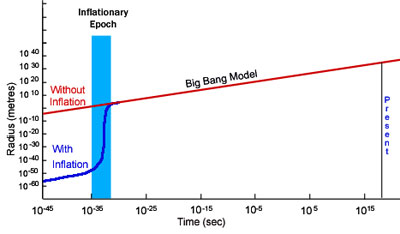Cosmic Microwave Background
According to Big Bang theory, temperatures and pressures for the first ~300,000 years of the Universe were such that atoms could not exist. Matter was instead distributed as a highly ionised plasma which was very efficient at scattering radiation. The result was that information (photons) from the early Universe were effectively trapped in an inpenetrable ‘fog’ which, to this day, hides these early times from astronomers.
As the Universe expanded, however, its temperature and density dropped to a point where the atomic nuclei and electrons were able to combine to form atoms. This is known as the epoch of recombination, and it is at this time that photons were finally able to escape the fog of the early Universe and travel freely. The ‘Cosmic Microwave Background radiation’ (CMB) is the record of these photons at the moment of their escape.
First detected by Arno Penzias and Robert Wilson in 1965, the CMB is one of the most conclusive pieces of evidence in favour of the Big Bang. In particular, Big Bang theory predicts certain characteristics for the radiation left over from the birth of the Universe, all of which are confirmed by the CMB:
- The multiple scattering of photons by a hot plasma in the early Universe should result in a blackbody spectrum for the photons once they have escaped at the epoch of reionisation. This is exactly what is observed for the CMB. The figure on the right plots a theoretical blackbody curve along with CMB data from the COsmic Background Explorer (COBE) satellite. The agreement is so good that it is impossible to distinguish the data from the theoretical curve.
- The photons of the CMB were emitted at the epoch of recombination when the Universe had a temperature of about 3,000 Kelvin. However, they have been cosmological redshifted to longer wavelengths during their ~13 billion year journey through the expanding Universe, and are now detected in the microwave region of the electromagnetic spectrum at an average temperature of 2.725 Kelvin. This agrees well with what Big Bang theory predicts.
However, standard Big Bang theory does not account for all of the observed properties of the CMB. In particular, once we remove the dipole that arises due to our motion in the Universe, the CMB is incredibly uniform across the sky, varying by no more than one part in ten thousand. This suggests that regions of the Universe that are now widely separated, were once close enough to ‘communicate’ with each other in order to equalise their temperature. However, this is not possible given standard Big Bang theory, the age of the Universe, and the finite speed of light.
The red line in the figure on the left shows that according to Big Bang theory, the Universe had a radius of more than 10-10 metres at 10-45 seconds after the Big Bang. Since the speed of light travels at 3×108 m/s, information could only have travelled ~3×10-37 metres during this time. Big Bang theory therefore makes it impossible for the whole Universe to have equalised its temperature at these early times, as not all the Universe was in communication. In everyday life we cannot receive information beyond our horizon, so this is known as the horizon problem.
To resolve the horizon problem, astronomers introduced an inflationary period into the Big Bang model (blue region in figure). This sudden increase in the rate of expansion of the Universe soon after the Big Bang, resolves not only the horizon problem, but also the flatness problem. It has therefore been accepted as part of the current concordance model of cosmology.
The presence of a background radiation which has a temperature, spectrum and uniformity consistent with Big Bang cosmology and inflation, is extremely difficult to produce by any other means. Therefore, astronomers believe that by studying the properties of the CMB, they are in fact studying the conditions of the early Universe.
Study Astronomy Online at Swinburne University
All material is © Swinburne University of Technology except where indicated.




